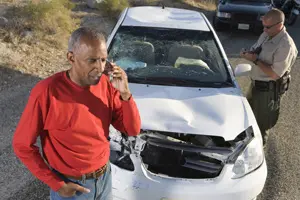 The injuries that you would obtain if you get rear-ended can be different than if you were hit head-on or from the side. Different muscles, ligaments, vertebrae, and body parts are stressed depending on the specifics of the accident. Being rear-ended is the most common type of accident and whether it’s a small “fender bender” or the person who hit you was traveling at a high rate of speed, you could be seriously injured. Even in low-speed accidents, major injuries can occur that require medical attention.
The injuries that you would obtain if you get rear-ended can be different than if you were hit head-on or from the side. Different muscles, ligaments, vertebrae, and body parts are stressed depending on the specifics of the accident. Being rear-ended is the most common type of accident and whether it’s a small “fender bender” or the person who hit you was traveling at a high rate of speed, you could be seriously injured. Even in low-speed accidents, major injuries can occur that require medical attention.
Whiplash is probably the most common of all auto accident injuries. This occurs when the head is jerked backward and then forward when the car is struck, straining the neck muscles.
This happens in an accident when your spine doesn’t get a chance to stabilize itself before you are hit. It can take months of specialized treatment and hands-on spinal manipulation to recover from this type of injury.
A concussion is a type of traumatic head injury that happens when there is a blow to the head and your brain moves around in your skull. In an accident, you can hit your head even if you’re wearing your seatbelt. Despite the fact that concussions are an extremely common form of trauma, that doesn’t make them any less dangerous or less difficult to recover from.
 Injury to your brain in an accident can be even more serious than a concussion. If there is such force that the brain is penetrated or fractured, a contusion, or bruising of the brain, may occur or brain hemorrhaging, bleeding of the brain, could happen. The frightening thing about traumatic brain injury is that you may not know that it has happened to you right away. That’s why it is important to see a doctor immediately following a car accident.
Injury to your brain in an accident can be even more serious than a concussion. If there is such force that the brain is penetrated or fractured, a contusion, or bruising of the brain, may occur or brain hemorrhaging, bleeding of the brain, could happen. The frightening thing about traumatic brain injury is that you may not know that it has happened to you right away. That’s why it is important to see a doctor immediately following a car accident.
You can break any number of bones in an accident, but one of the major dangers attributed to broken bones is that it may damage an organ like a broken rib puncturing a lung.
When glass shatters, chemicals are splattered, or car parts break free, you could experience facial disfigurement. Even the airbag that may be saving you from more serious injury or death can cause damage to your face.
Spinal cord damage can cause severe nerve damage that can result in full or partial paralysis or loss of sensation in the legs and feet. In the most severe cases, the person may be paralyzed permanently.
The most alarming aspect of these injuries is that they do not always show up right away. It may take weeks for some of them to appear. When you’re in an accident, your body floods itself with adrenaline to mask its injuries which is a throwback to our neanderthal days when they needed to get out of a dangerous situation immediately in order to survive; being attacked by a saber-toothed tiger, for example. You may also think you feel a bit sore for a few days after the accident merely because of the ordeal that your body experienced, but it could be a symptom of a much more serious problem.
In the state of Florida, you only have 14 days to be seen by a physician in order to file an insurance claim, so it’s vital that, even if you’ve been in a low-speed fender bender, you see a doctor as soon as possible. Don’t wait for that time to elapse, or for symptoms to get worse: schedule an appointment with an auto injury doctor today.
The doctors at Complete Care are specialists in detecting and diagnosing hidden injuries that occurred in automobile accidents. If you’ve been in an accident, request an appointment today. Our auto accident doctors will not only diagnose and come up with a comprehensive treatment plan, they will also help you fill out any necessary forms and walk you through the entire process to ensure you’re getting the treatment you need.
The information provided on this website does not, and is not intended to, constitute legal advice; instead, all information, content, and materials available on this site are for general informational purposes only. Information on this website may not constitute the most up-to-date legal or other information. This website contains links to other third-party websites. Such links are only for the convenience of the reader, user or browser.